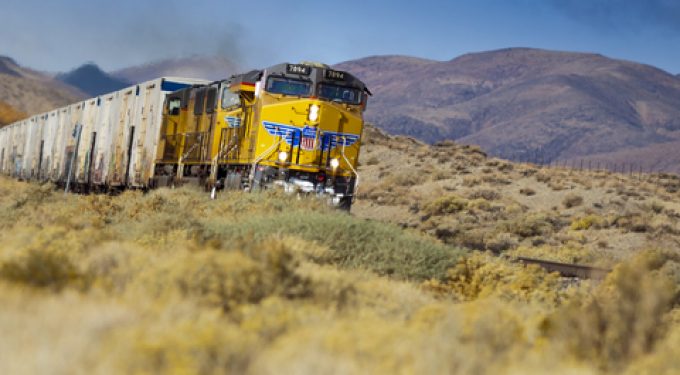New STB chair orders railway CEOs to attend forum on declining volumes
Robert Primus, the new chairman of the US Surface Transportation Board (STB), has called in ...
TFII: SOLID AS USUALMAERSK: WEAKENINGF: FALLING OFF A CLIFFAAPL: 'BOTTLENECK IN MAINLAND CHINA'AAPL: CHINA TRENDSDHL: GROWTH CAPEXR: ANOTHER SOLID DELIVERYMFT: HERE COMES THE FALLDSV: LOOK AT SCHENKER PERFORMANCEUPS: A WAVE OF DOWNGRADES DSV: BARGAIN BINKNX: EARNINGS OUTODFL: RISING AND FALLING AND THEN RISING
TFII: SOLID AS USUALMAERSK: WEAKENINGF: FALLING OFF A CLIFFAAPL: 'BOTTLENECK IN MAINLAND CHINA'AAPL: CHINA TRENDSDHL: GROWTH CAPEXR: ANOTHER SOLID DELIVERYMFT: HERE COMES THE FALLDSV: LOOK AT SCHENKER PERFORMANCEUPS: A WAVE OF DOWNGRADES DSV: BARGAIN BINKNX: EARNINGS OUTODFL: RISING AND FALLING AND THEN RISING

The Federal Railroad Administration (FRA), a government agency under the umbrella of the US Department of Transportation, has voiced concerns about safety standards at Union Pacific (UP).
In a letter to top UP executives, federal railroad administrator Amit Bose expressed concern that defects found in a recent unscheduled inspection could represent a “significant risk to rail safety”.
FRA inspectors had visited UP’s largest railyard in western Nebraska and their report showed a 19.93% defect rate on railcars and a 72.69% defect rate on locomotives – both twice the national average, it said.
“The compliance of the rolling stock (freight cars and locomotives) on the UP network is poor, and UP was unwilling or unable to take steps to improve the condition of the equipment,” wrote Mr Bose.
The letter also raised the question of whether the defect rate might be related to recent lay-offs at UP, when 44 carmen and 94 locomotive craft employees were terminated.
“This begs the question: was UP’s failure to improve the condition of rolling stock […] a result of not having the personnel to make the necessary repairs because of recent furloughs?” asked Mr Bose.
After a telephone conversation with Mr Bose, UP CEO Jim Vena, who recently took over the reins, wrote to the administrator reiterating: “Union Pacific will never compromise on the safety of our employees. Safety is always our first priority, and we are reviewing and will address the concerns raised by the FRA.”
He asked for details of the defects found during the inspection and their magnitude, which he said had not been spelled out in Mr Bose’s letter.
He also defended a perceived resistance to FRA inspectors’ requests to check certain areas at the yard, saying these were measures in line with standard procedures to keep inspectors safe and to avoid service interruptions by unscheduled inspections.
As for the furloughs, he said these were the result of lower business volumes, which had caused more equipment to be put into storage. And he added: “There is no correlation between recent furloughs and Union Pacific’s ability to address mechanical repairs. Mechanical employee-to-car and locomotive ratios are in line with our long-term trend, as well as those across the industry.”
The issue for UP comes as the National Transportation Safety Board opened a public docket for its investigation of an accident on 8 September last year, when a UP train collided with railcar stores in a siding in California and a conductor and an engineer were killed.
Rail safety has been under even more scrutiny in the US since the derailment of a Norfolk Southern train at the town of East Palestine, Ohio, in February, which caused the evacuation of residents owing to fire and hazardous chemicals on the train. It prompted an outcry and triggered a slew of legislative initiatives to tighten rail safety regulations, both at federal and state levels.
Recently, concerns have grown about the progress of some of these initiatives. According to some reports, some of the mandates have been watered down in the committees on Capitol Hill, despite pledges of support from the Class I carriers. The bipartisan Railway Safety Act has stalled in the Senate, which has been blamed on resistance from Republican lawmakers.
Despite considerable efforts and spending to address the fall-out of the East Palestine derailment, Norfolk Southern has come under renewed criticism for its safety culture in a 143-page report released by the FRA this week. It acknowledged renewed commitments from the railway’s leadership to improve safety, but criticised poor communications, mistrust between employees and managers and inadequate training as obstacles to enhanced safety.
In June, the Biden administration pledged $570m for improvements in rail safety. The bulk of this money appears to be going toward level crossings, so the freight carriers are not likely to see a substantial infusion of public money into their safety issues.
Comment on this article